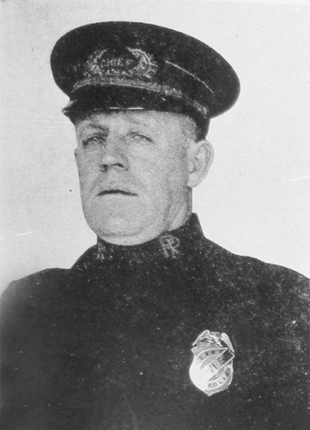
J. M. Kirkley, Chief of Police
Reno Nevada 1919 -1935
Andrew Alex Burke was born in 1865 at Ukiah California where it is believed he grew up. At the age of 23, on September 22, 1888 he married Mattie E. Shore of Ukiah. About ten years later he migrated to Nevada and became employed as a Wells-Fargo messenger which at the time messengers were armed guards protecting valuable cargo being transport by train and stage in Nevada.
Other than his experience as a Wells-Fargo guard, Burke seems to have no law enforcement experience. Burke even acknowledge to news reporters as he became chief of police that he was new in the business.
Councilman Jamison, Quinn and Nelson joined with Mayor Richard Kirman to remove Leeper and appoint Burke as chief of police. However, in addition to selling property to Burke to assure he qualified to be chief under the city charter, Councilman Lyle Jamison, also collected the two required signatures for the $2000 bond required of Alex Burke to become chief. Earlier in the year as the new Reno city Council took office and the new Mayor, Dick Kirman, reappointed Leeper to head the police department, Lyle Jamison was the only councilman to vote against Leeper’s reappointment.
While nothing seemed to qualify Burke to be chief, he didn’t seem to be lacking the ability to do the job. Physically fit and over 6 feet tall he gave a commanding presence. The Reno Gazette acknowledged that he was well known, but not widely know in Reno. He obviously had the ability to gather support to be appointed to a position that several other people with law enforcement experience wanted.
*** LINKS TO ADDITIONAL READING ***
1908 Reno Police Department Manual
John (Jack) M. Kirkley, Chief of Police - 1919-1935
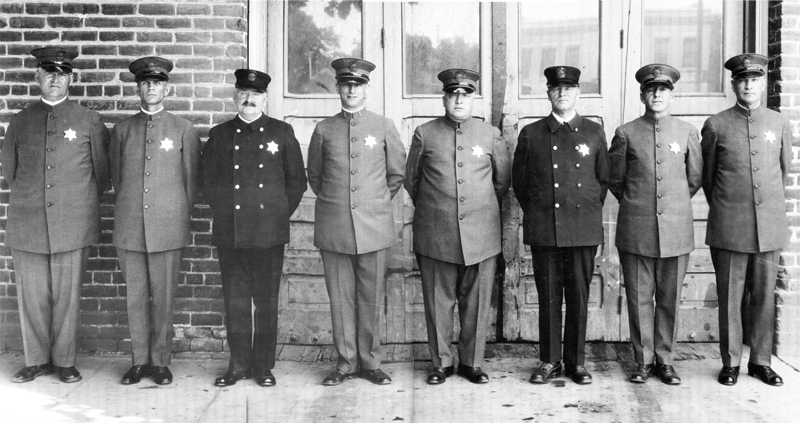
The Reno Police Department as it appeared not long after J. M. Kirkley took office approximately 1920. Chief is third from the right in the dark uniform.
The Reno Police Department as it appeared not long after J. M. Kirkley took office approximately 1920. Chief is third from the right in the dark uniform.
CHIEF JACK KIRKLEY – LONGEST SERVING CHIEF OF POLICE
by Jim Gibbs
All eyes turned to Reno on June 21, 1910 with the exciting news that the small city would soon be hosting the heavyweight championship battle between Jack Johnson and Jim Jeffries. The catch? The fight was just two weeks away.
Boxing promoter George Lewis “Tex” Rickard had originally intended to hold the highly-anticipated event in San Francisco, but a last-minute cancellation by wary California Governor James N. Gillette forced a change of venue. Reno’s leaders campaigned vigorously for the fight, convincing Rickard they could be ready in time for the scheduled date of July 4th.
The bout was promoted in advance as the “Fight of the Century”—a rather brash claim, considering the century was just a decade old—but the import of the fight was undeniable. By 1908, black fighter Jack Johnson had ascended to the top of the sport. Promoters eager to find a “Great White Hope” to seize his crown convinced Jim Jeffries to come out of retirement and reclaim the heavyweight title for white America. Having retired undefeated in 1904 as the heavyweight champion of the world, Jeffries was considered still deserving of the title by many, amid rampant racial prejudice.
The two competitors arrived in town in advance to train—Jim Jeffries at Moana Springs, south of town, and Jack Johnson to the west at Rick’s Resort. On June 23, workers began to construct a massive wooden amphitheater on land owned by Patrick Flanigan on East 4th Street, the site of the 1905 Hart-Root fight. On the eastern edge of city limits, the location was conveniently situated near both the Southern Pacific railroad tracks and the streetcar line joining Reno and Sparks. Supervised by San Francisco architect W.L. McLaughlin, a crew of up to 300 men at a time toiled for ten hours a day, supplied with whiskey breaks by contractor Charles Friedhoff.
It was the most publicized sporting event in American history to that date. Attendance was estimated at more than 20,000, with live telegraph coverage keeping the world riveted and nine cameramen documenting the event from different angles.
RENO POLICE DEPARTMENT APPROXIMATELY 1926-28
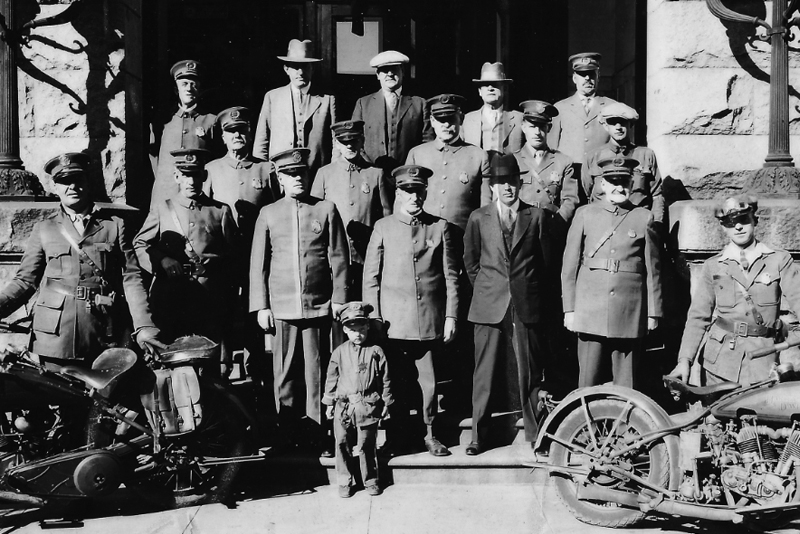
The Reno Police Department with Chief of Police Jack Kirkley standing behind his son Jack Jr. who would later become a Reno Police officer. The photo was taken on the steps of the Reno Police Department on Center Street which is now the Cal-Neva Parking lot.
The Reno Police Department with Chief of Police Jack Kirkley standing behind his son Jack Jr. who would later become a Reno Police officer. The photo was taken on the steps of the Reno Police Department on Center Street which is now the Cal-Neva Parking lot.
NEVADA PEACE OFFICERS JOIN TOGETHER TO HANDLE LARGEST CROWD EVER
The crowd came to see the “Battle of the Century”. Whether it came up to their expectations or not is not the debatable point. They came to Reno loaded with the fight spirit. It is estimated that the attendance of the fight was 20,000. The southern Pacific Railroad recorded 16,000 passengers delivered to Reno for the fight. At the time, Reno had a population of 10,867 and a police department of 10-12 individuals including Chief Burke.
There is also to be considered the fact that the “Battle of the Century” was one between representatives of races, rather than between individuals of the same color and condition. Racial prejudice was clearly shown in the conversations about the bout between Jeffries and Johnson.
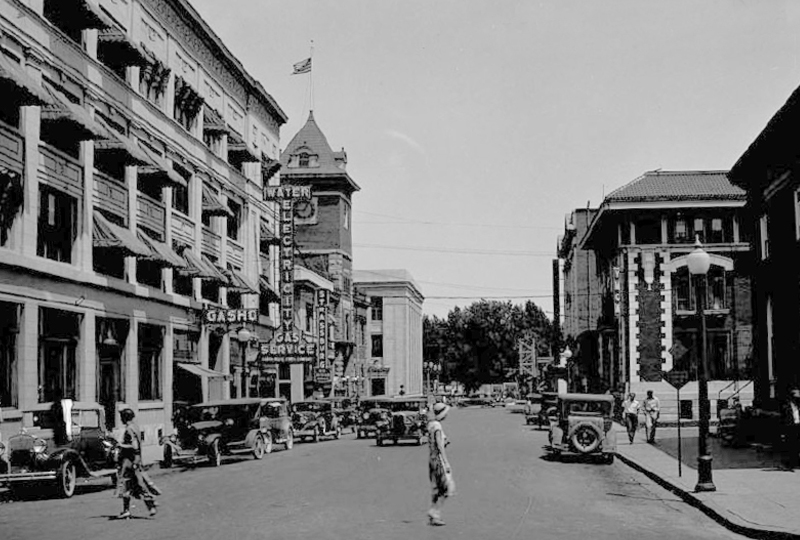
Early 1930s Looking East down Front Street (now 1st Street) towards City Hall on the left with the flag on the tower. The Reno Police station would be just around the corner of City Hall on Center Street. The building on the left in the foreground is where the current city Hall is located.
Early 1930s Looking East down Front Street (now 1st Street) towards City Hall on the left with the flag on the tower. The Reno Police station would be just around the corner of City Hall on Center Street. The building on the left in the foreground is where the current city Hall is located.
With it all, the spectators, numbering twice the population of Reno uttered not a word of anger when the negro felled the Caucasian and was proclaimed his victor. That was not the situation throughout the United States as race riots erupted in various places. Maybe the crowd in Reno knew the truth as they watched the event. They witnessed the “Great White Hope” knocked to the canvas fairly by his black victor. But rumors of Jeffries being doped ran amuck and in many cities photos of the fight, especially the image of Johnson standing over Jeffries down on a knee clinging to the ropes, were banned.
It is well that the crowd in Reno was orderly, for there were hundreds of armed and determined deputies in the arena to make certain that the black man would receive fair treatment. While the Reno Police Department participated in maintaining order at the area which was on the Northeastern edge of town, the ultimate law enforcement responsibility on the day of the fight fell onto the shoulders of Sheriff Charley Ferrel.
To handle the crowd, Sheriff Ferrel reportedly deputized 100 plus special deputies. He also relied upon Reno Chief of Police, Burke, the Reno Township Constable Christie, United States Marshal Humphreys, Superintendent Cox of the state police and Assistant Chief Harrold of the Southern Pacific detective force.
All in all, the crowd dispersed about as quickly as they arrive and soon again the hotels had room available, the local merchants had cash in hand and the Reno Police Department was dealing with the occasional petty thief and the town drunks.
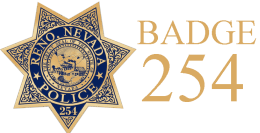
SHARE THIS PAGE!